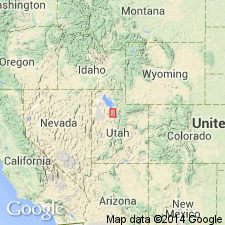
- Usage in publication:
-
- Jordan marker bed*
- Modifications:
-
- Revised
- AAPG geologic province:
-
- Great Basin province
Summary:
Assigned as a bed, an informal unit, in Clipper Ridge Member (new) of Bingham Mine Formation (new) of Oquirrh Group (rank raised) in the measured type section of Clipper Ridge in N1/2 sec 6, T4S, R3W and S1/2 sec 31, T3S, R3W, Bingham Canyon quad, Tooele Co, UT, Great Basin province. Formerly considered a member, Jordan Limestone Member of Bingham Quartzite. Lies 10 ft above lower contact of member above a tan orthoquartzite. Is 361 ft thick at measured section where it consists of dark to medium gray arenaceous limestone, cherty limestone, silty limestone, and calcareous sandstone that are interbedded. Is thin- to medium-bedded, locally banded and cross-bedded. Has abundant chert in thin nodular layers in lower part. Fossils: bryozoans, brachiopods, corals, and fusulinids. Underlies a calcareous quartzite, arenaceous limestone, and calcareous sandstone sequence of Clipper Ridge Member. Of Late Pennsylvanian, Missourian age. Columnar sections.
Source: GNU records (USGS DDS-6; Denver GNULEX).
For more information, please contact Nancy Stamm, Geologic Names Committee Secretary.
Asterisk (*) indicates published by U.S. Geological Survey authors.
"No current usage" (†) implies that a name has been abandoned or has fallen into disuse. Former usage and, if known, replacement name given in parentheses ( ).
Slash (/) indicates name conflicts with nomenclatural guidelines (CSN, 1933; ACSN, 1961, 1970; NACSN, 1983, 2005, 2021). May be explained within brackets ([ ]).

